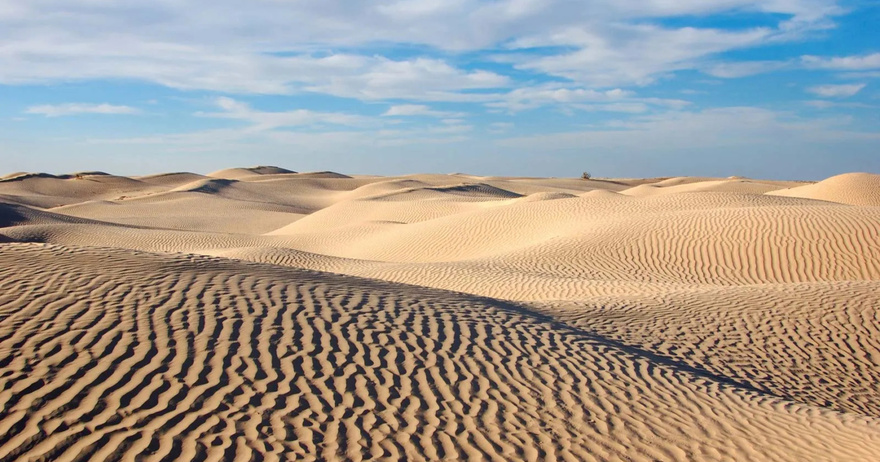The Sahara’s Surprising Transformation
The Sahara Desert, known as one of the hottest and driest places on Earth, has recently undergone a dramatic transformation. Due to heavy rainfall, parts of this typically barren landscape are now turning green, showcasing an unexpected burst of life. This rare greening provides a unique glimpse into the Sahara’s ancient history and hints at the potential impacts of climate change on the region.

Unprecedented Rainfall in the Sahara
In September 2024, an extratropical cyclone swept across parts of northwestern Africa, including Morocco, Algeria, Tunisia, and Libya. Areas known for their extreme aridity received several inches of rain—an amount they would typically expect in a year or more. This deluge, captured by NASA’s satellite imagery, revealed patches of vibrant greenery sprouting up across the desert, a rare sight that amazed both scientists and locals.
Climate researcher Sylwia Trzaska explains that shrubs and trees, especially in low-lying areas like riverbeds, responded almost instantly to the rainfall. This short-lived transformation highlights the resilience of the desert’s vegetation, which waits patiently for moisture to reemerge.
The Sahara’s Lush Past
Despite its current harsh conditions, the Sahara was not always a vast desert. Between 11,000 and 5,000 years ago, it was a verdant region filled with lakes and lush vegetation. The recent rains have allowed dormant seeds and plants to come alive, giving a brief glimpse into this ancient green landscape. Peter de Menocal, president of the Woods Hole Oceanographic Institution, notes, “Exceptional rainfall events turn the dunes into flowered fields, showing how quickly the landscape can change.”
Flooding and Lake Revival
In addition to plant growth, the rainfall has led to rare occurrences of lake formations. Areas like Sebkha el Melah, a salt flat in Algeria, have filled with water for the first time in years. Moshe Armon from the Hebrew University of Jerusalem points out that such events have only happened a few times in the last two decades, underscoring how exceptional this recent rainfall has been.
Climate Change’s Role in the Sahara’s Greening
The heavy rainfall in the Sahara is linked to shifting global weather patterns. One significant factor is the northward movement of the Intertropical Convergence Zone (ITCZ), a tropical rain belt that usually brings rainfall to equatorial regions. Due to unusually high ocean temperatures, particularly in the Atlantic, this rain belt has extended further north, bringing storms and unprecedented rainfall to the Sahara.
However, climate experts caution that as other ocean temperatures rise, the ITCZ may gradually shift back south. For now, the Sahara is experiencing a temporary, unusual greening, but its future under climate change remains uncertain.
Flooding and Its Impact on African Communities
While the greening of the Sahara is captivating, the rainfall has brought devastation to some African communities. Flooding has affected millions across 14 African countries, including Chad, Nigeria, and Niger, resulting in over 1,000 fatalities. Although much of the rain fell in sparsely populated areas, its impact on human lives has been severe, with extensive flooding causing displacement and damage to property.
A Glimpse into the Sahara’s Ancient Climate and Future Possibilities
The Sahara’s brief return to greenery serves as a reminder of its ancient climate, when it was once filled with lakes and vegetation. For scientists, this rare event offers an invaluable opportunity to study how climate change might continue to impact the desert’s ecosystem. Some researchers, like de Menocal, believe that with changing weather patterns, the Sahara could experience more episodes of rainfall in the future, leading to similar temporary transformations.
While the recent rains may be short-lived, they suggest a potential for future renewal, even in the world’s driest places. As experts continue to study the effects of climate change, the Sahara’s surprising response to rain may provide valuable insights into how other arid regions could evolve in a warmer, wetter world.
Conclusion
The heavy rainfall across the Sahara has led to an extraordinary and brief transformation, with greenery unexpectedly emerging across the desert’s sands. This unusual greening not only reminds us of the Sahara’s ancient climate but also offers a fascinating perspective on the possible effects of shifting global weather patterns. Although temporary, these changes reveal how even the most desolate places on Earth can respond dynamically to environmental shifts, offering a glimpse into the potential future of the Sahara Desert.
Κηδεύτηκε στα Τρίκαλα ο Νίκος Παλαιοκώστας – Με παρουσία αστυνομίας
Στη φόρα τρεις δεκαετίες αργότερα: Η αληθινή ηλικία της Αλίκης Βουγιουκλάκη, τόσα χρόνια έκρυβε τελικά
«Τρεις γενιές Καζάκοι»: Ο Κωνσταντίνος Καζάκος αγκαλιά με τον γιο του και όλοι παρατήρησαν το ίδιο πράγμα
«Ο άντρας μου με απατά και ξέρω και με ποια. Με το που είδα αυτό στα σκουπίδια τα κατάλαβα όλα αμέσως»






























